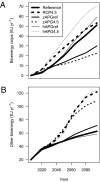Climate mitigation and the future of tropical landscapes
- PMID: 20921413
- PMCID: PMC2993329
- DOI: 10.1073/pnas.0910467107
Climate mitigation and the future of tropical landscapes
Abstract
Land-use change to meet 21st-century demands for food, fuel, and fiber will depend on many interactive factors, including global policies limiting anthropogenic climate change and realized improvements in agricultural productivity. Climate-change mitigation policies will alter the decision-making environment for land management, and changes in agricultural productivity will influence cultivated land expansion. We explore to what extent future increases in agricultural productivity might offset conversion of tropical forest lands to crop lands under a climate mitigation policy and a contrasting no-policy scenario in a global integrated assessment model. The Global Change Assessment Model is applied here to simulate a mitigation policy that stabilizes radiative forcing at 4.5 W m(-2) (approximately 526 ppm CO(2)) in the year 2100 by introducing a price for all greenhouse gas emissions, including those from land use. These scenarios are simulated with several cases of future agricultural productivity growth rates and the results downscaled to produce gridded maps of potential land-use change. We find that tropical forests are preserved near their present-day extent, and bioenergy crops emerge as an effective mitigation option, only in cases in which a climate mitigation policy that includes an economic price for land-use emissions is in place, and in which agricultural productivity growth continues throughout the century. We find that idealized land-use emissions price assumptions are most effective at limiting deforestation, even when cropland area must increase to meet future food demand. These findings emphasize the importance of accounting for feedbacks from land-use change emissions in global climate change mitigation strategies.
Conflict of interest statement
The authors declare no conflict of interest.
Figures




Similar articles
-
Climate impacts on European agriculture and water management in the context of adaptation and mitigation--the importance of an integrated approach.Sci Total Environ. 2010 Nov 1;408(23):5667-87. doi: 10.1016/j.scitotenv.2009.05.002. Epub 2009 Jun 5. Sci Total Environ. 2010. PMID: 19501386
-
Large uncertainty in carbon uptake potential of land-based climate-change mitigation efforts.Glob Chang Biol. 2018 Jul;24(7):3025-3038. doi: 10.1111/gcb.14144. Epub 2018 Apr 16. Glob Chang Biol. 2018. PMID: 29569788
-
Landscape patterns of bioenergy in a changing climate: implications for crop allocation and land-use competition.Ecol Appl. 2016 Mar;26(2):515-29. doi: 10.1890/15-0545. Ecol Appl. 2016. PMID: 27209792
-
Co-benefits, trade-offs, barriers and policies for greenhouse gas mitigation in the agriculture, forestry and other land use (AFOLU) sector.Glob Chang Biol. 2014 Oct;20(10):3270-90. doi: 10.1111/gcb.12591. Epub 2014 May 8. Glob Chang Biol. 2014. PMID: 24700759 Review.
-
Greenhouse gas mitigation on marginal land: a quantitative review of the relative benefits of forest recovery versus biofuel production.Environ Sci Technol. 2015 Feb 17;49(4):2503-11. doi: 10.1021/es502374f. Epub 2015 Jan 29. Environ Sci Technol. 2015. PMID: 25582654 Review.
Cited by
-
Global projections of 21st century land-use changes in regions adjacent to Protected Areas.PLoS One. 2012;7(8):e43714. doi: 10.1371/journal.pone.0043714. Epub 2012 Aug 30. PLoS One. 2012. PMID: 22952744 Free PMC article.
-
Projecting state-level air pollutant emissions using an integrated assessment model: GCAM-USA.Appl Energy. 2017 Dec 15;208:511-521. doi: 10.1016/j.apenergy.2017.09.122. Appl Energy. 2017. PMID: 30046218 Free PMC article.
-
Spatially explicit terrestrial carbon densities for calibrating the carbon cycle in human-Earth system Models.Sci Data. 2025 Apr 16;12(1):638. doi: 10.1038/s41597-025-04723-4. Sci Data. 2025. PMID: 40240400 Free PMC article.
-
Predicting tropical dry forest successional attributes from space: is the key hidden in image texture?PLoS One. 2012;7(2):e30506. doi: 10.1371/journal.pone.0030506. Epub 2012 Feb 20. PLoS One. 2012. PMID: 22363443 Free PMC article.
-
Going Global to Local: Connecting Top-Down Accounting and Local Impacts, A Methodological Review of Spatially Explicit Input-Output Approaches.Environ Sci Technol. 2019 Feb 5;53(3):1048-1062. doi: 10.1021/acs.est.8b03148. Epub 2019 Jan 25. Environ Sci Technol. 2019. PMID: 30525491 Free PMC article.
References
-
- Canadell JG, Raupach MR. Managing forests for climate change mitigation. Science. 2008;320:1456–1457. - PubMed
-
- Angelsen A, Kaimowitz D. Rethinking the causes of deforestation: Lessons from economic models. World Bank Res Obs. 1999;14:73–98. - PubMed
-
- Wise M, et al. Implications of limiting CO2 concentrations for land use and energy. Science. 2009;324:1183–1186. - PubMed
-
- Melillo JM, et al. Indirect emissions from biofuels: How important? Science. 2009;326:1397–1399. - PubMed
-
- DeFries R, et al. Deforestation driven by urban population growth and agricultural trade in the twenty-first century. Nat Geosci. 2010;3:178–181.
Publication types
MeSH terms
Substances
LinkOut - more resources
Full Text Sources
Medical

